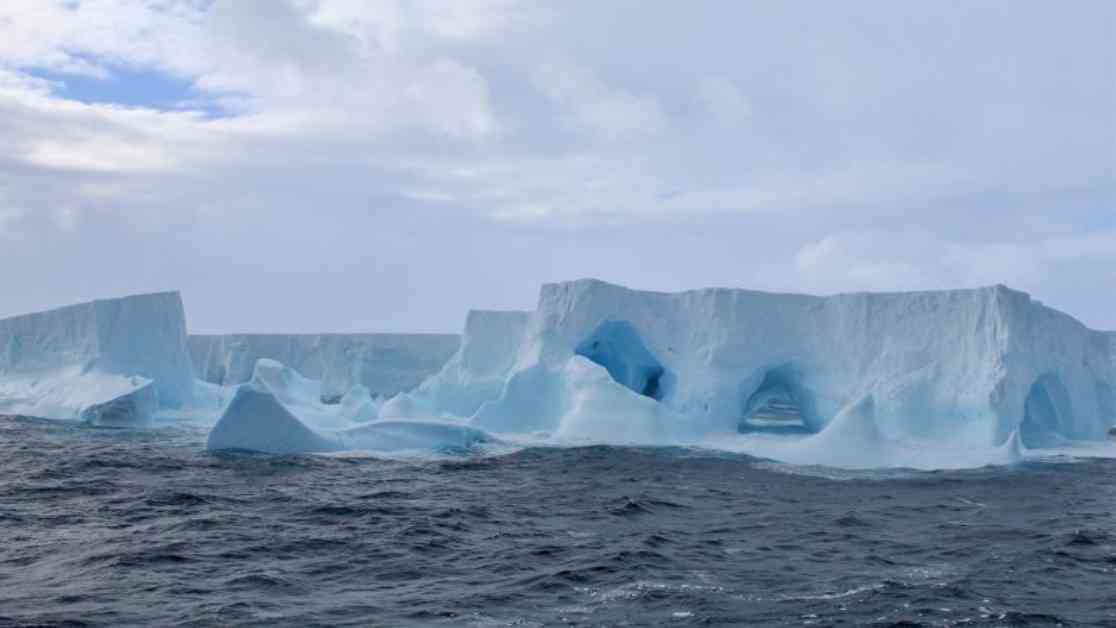Iceberg A23a, the world’s largest iceberg, has captured the attention of scientists as it remains trapped in a spinning vortex in the Southern Ocean. This colossal iceberg, which broke off from Antarctica’s Filchner-Ronne ice shelf in 1986, has been slowly rotating in one spot due to a rare set of circumstances that experts say is unprecedented. Dr. Les Watling, a professor emeritus of life sciences with the University of Hawaii at Manoa, described the situation as unique, stating, “This has never happened before as far as we all know.”
The massive iceberg, measuring approximately 3,672 square kilometers (1,418 square miles), is slightly bigger than Rhode Island and more than twice the size of the city of London. It drifted over a seamount in the Southern Ocean and became stuck in a phenomenon known as a Taylor column, a spinning vortex of water caused by ocean currents hitting the underwater mountain. The British Antarctic Survey reported that the iceberg is rotating about 15 degrees a day due to the currents created by the seamount.
The peculiar spin of iceberg A23a has fascinated scientists, as it offers insight into the life cycle of icebergs and how the climate crisis impacts Antarctic ice sheets. While the iceberg is slowly melting, experts assure that it will not contribute to rising sea levels. Dr. Alexander Brearley, a physical oceanographer with British Antarctic Survey, explained that the iceberg’s unique position within the Taylor column allows it to melt more slowly than it would have if it continued on its journey.
The journey of iceberg A23a began in the 1980s when it broke off from the ice shelf and grounded on the bottom of the Weddell Sea. After melting in place for over three decades, it started drifting towards the Antarctic Circumpolar Current in 2020. However, the iceberg’s progress was halted when it reached the current and became trapped above the Pirie Bank Seamount, an underwater mountain approximately 1,000 meters tall. The iceberg’s size and position within the Taylor column have prevented it from being pushed away easily, leading to its slow rotation above the seamount.
Researchers from the British Antarctic Survey have been monitoring the iceberg’s movement through satellite imagery, revealing its stationary position near the South Orkney Islands. The slow spin of the iceberg is not visible in real time, but it has provided scientists with valuable insights into oceanographic phenomena. Dr. Brearley noted that the iceberg’s entrapment in the Taylor column was a rare occurrence, as such events have not been extensively studied in relation to icebergs.
While the spinning iceberg remains a scientific curiosity, experts emphasize that there is no immediate cause for concern. Iceberg calving is a natural process along the Antarctic coastline, and individual events like the entrapment of A23a are part of Earth’s natural cycle. However, the thinning of ice shelves in West Antarctica due to the climate crisis is a pressing issue that can lead to increased iceberg calving and contribute to rising sea levels. Dr. Brearley highlighted the importance of understanding the implications of iceberg movements on land-based ice stability for future climate scenarios.
As researchers continue to monitor the spinning iceberg, they draw parallels to a 2015 study that found an oceanographic instrument remaining in a Taylor column for four years. While the instrument was significantly smaller than iceberg A23a, researchers believe that a combination of external factors such as wind variations and currents may eventually move the iceberg out of the vortex. Dr. Tony Koslow, a research oceanographer emeritus with the Scripps Institution of Oceanography, emphasized the role of the seamount’s size in trapping the iceberg for an extended period.
Seamounts like the Pirie Bank Seamount are known for their biodiversity, as the currents surrounding these underwater mountains create ideal conditions for marine life. While the melting of the iceberg may affect the natural ecosystem around the seamount, further research is needed to understand the long-term impacts. Dr. Watling highlighted the potential reduction in biodiversity and food supply to benthic communities due to the iceberg’s presence in the water column, but he reassured that there is no immediate cause for concern.
In conclusion, the world’s largest iceberg, A23a, remains a captivating subject of study for scientists as it continues to spin in the Southern Ocean. While the iceberg’s entrapment in a Taylor column is a rare occurrence, it offers valuable insights into oceanographic phenomena and the impact of climate change on Antarctic ice sheets. Researchers will continue to monitor the iceberg’s movement and study its effects on the surrounding marine ecosystem. The spinning iceberg serves as a reminder of the complex interactions between icebergs, ocean currents, and underwater mountains in the Southern Ocean.
